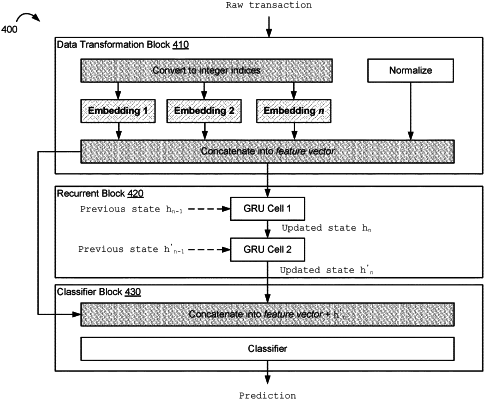| CPC G06N 3/045 (2023.01) [G06F 7/08 (2013.01); G06F 16/2379 (2019.01); G06F 16/27 (2019.01); G06N 3/042 (2023.01); G06N 3/044 (2023.01); G06N 3/063 (2013.01); G06N 3/08 (2013.01); G06Q 20/4016 (2013.01); G06Q 20/409 (2013.01); G06Q 40/12 (2013.12)] | 21 Claims |

|
1. A method, comprising:
receiving data of a first transaction;
retrieving a first state, wherein the first state is:
a default state in the event the first transaction is associated with an entity that has not been previously seen; or
a saved recurrent neural network state for an entity associated with the first transaction in the event the first transaction is associated with an entity that has been previously seen;
providing the retrieved first state and an input data based on the first transaction to a machine learning trained recurrent neural network model to determine a new second state;
determining a prediction result associated with a fraud threat of the first transaction using at least (i) the first state and (ii) the input data based on the first transaction;
updating the saved recurrent neural network state for the entity associated with the first transaction to be the second state associated with determining a likelihood that a future transaction is fraudulent, wherein the second state includes information applicable for the first transaction;
receiving data of a second transaction, wherein the second transaction is associated with the same entity as the first transaction and the first transaction and the second transaction are included in an interleaved sequence of transactions; and
unlooping a neural network associated with the saved recurrent neural network state including by:
retrieving the second state that is the saved recurrent neural network state for the entity associated with the second transaction and the first transaction;
providing the retrieved second state and an input data based on the second transaction to the machine learning trained recurrent neural network model to determine a new third state;
determining a prediction result associated with a fraud threat of the second transaction using at least (i) the second state and (ii) the input data based on the second transaction, wherein the second transaction is approved based at least in part a determination that the prediction result associated with the fraud threat of the second transaction is below a threshold; and
updating the saved recurrent neural network state for the entity to be the third state.
|